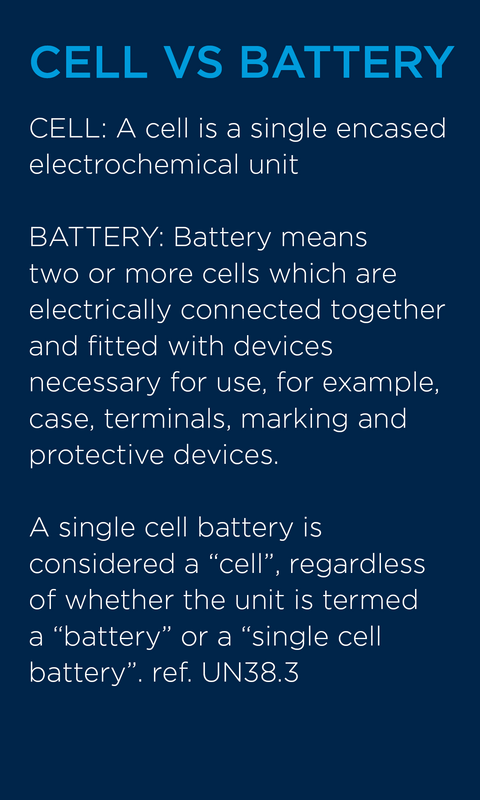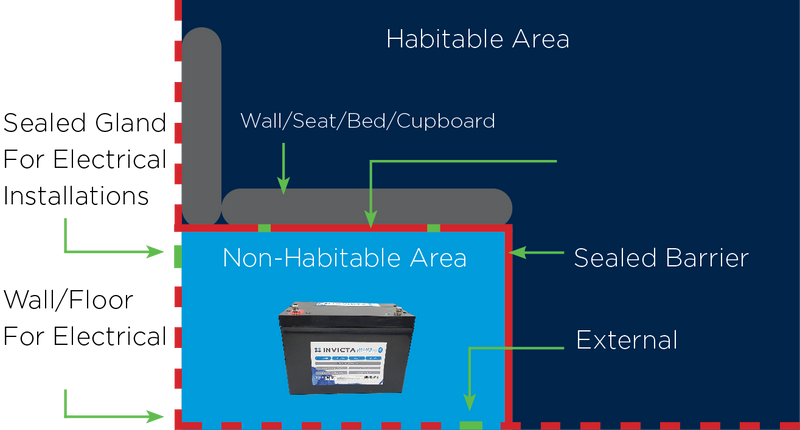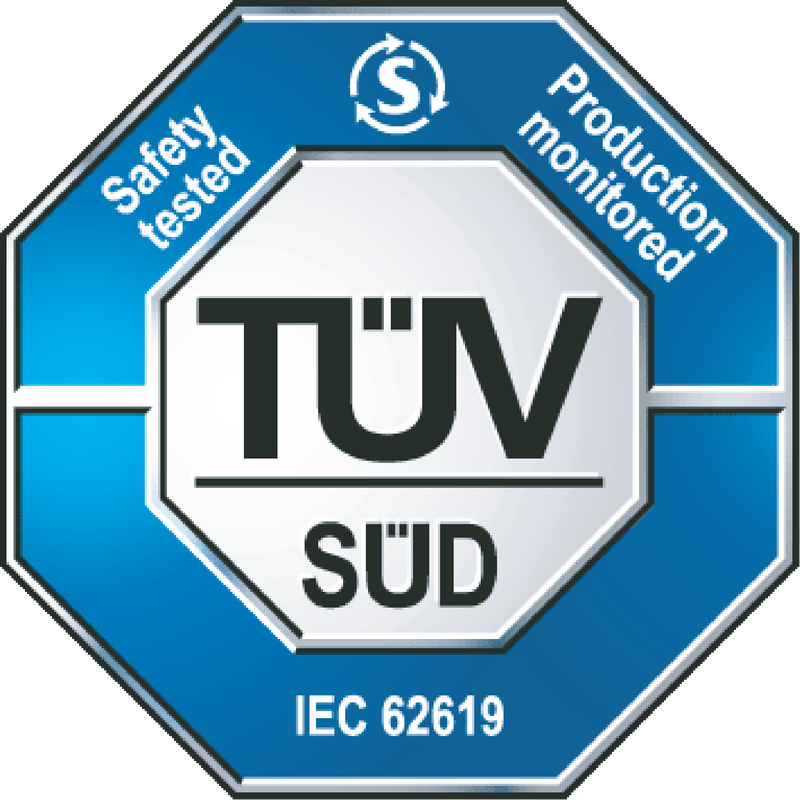Invicta Lithium Caravan Standards Update

Caravan Standards Update Introduction
The release of AS/NZS 3001.2:2022 has sparked significant interest and debate. Unfortunately, much of the information circulating is inaccurate or misinterprets the standard. We aim to offer an objective interpretation of the new caravan standards, emphasising its role in safeguarding lives and property through stringent safety measures. We are committed to compliance and certification, providing proof of rigorous testing to assure manufacturers, recreational vehicle users, and insurers that our batteries adhere to the standard’s safety goals, rather than attempting to manipulate it.
Our focus in this document is on Lithium Ion batteries and their installation, addressing the main sources of confusion. Through this document, we aim to shed light on the two most contentious clauses, battery certification and battery installation location, providing clarity from our perspective to promote safer practices in the caravan industry.
Download this update and guide
Summary
- Provide clarity around battery certification for AS 3001. 2.2022
- What is IEC 62619 and how does it relate to the new standard
- Provide clarity about where you can install a lithium battery in a caravan
- Other installation notes
- Checklist for Lithium Batteries
The Caravan Standards Are Here To Protect Your Property
And Family, Ensure You Are Compliant
Minimum Battery Requirements For Lithium Batteries
5.4.12.3.1 Requirements
Each lithium-ion battery shall be provided with a battery management safety system either integrated into a battery pack or as a separate component. All lithium ion batteries shall comply with AS IEC 62619.
The battery management safety system is designed to protect the lithium ion battery from potentially damaging situations.
The key point here is the statement “All lithium Ion batteries shall comply with IEC62619”. A “battery” includes both the battery management safety system and cells. Having only certified cells does not take into account intercell propagation and how the BMS (the key safety component) performs under adverse conditions to prevent any critical failure such as thermal runaway.
Only when the battery is IEC62619 certified can you be sure that all aspects of the battery, including the BMS and cells, are fully safety tested and compliant.
How Do I Tell If My Battery Is IEC 62619 Certified?
To tell if your batteries are IEC62619 certified there is one simply question you can ask the manufacturer. Do you have a certificate?
The only way to really know if the battery (or cells for that matter) are compliant is to ensure they have been tested to the standard and passed. A test certificate proves this is the case. If the manufacturer supplier cannot produce a test certificate then chances are their batteries, nor cells, are compliant to IEC62619. At Invicta we proudly show our certificate on our website.
Invicta IEC Certification Document
Other Safety Requirements For Lithium Batteries (BMS)
5.4.12.3.3 Electrical Protection
The battery management safety system shall continuously monitor the voltage, current and temperature of the battery and protect the following by automatic disconnection. Over and under-voltage, over and under temperature, and over current. The battery management system should be as per the cell manufacturer’s recommendation or designed and supplied by the same manufacturer.
The fact these sections are under the heading “5.4.12.3 Battery management safety system” should be enough to indicate that the entire battery should be certified, not just the cells.
Installation Location For Lithium Batteries
(internal to vehicle)
One of the largest point of contention is what constitutes “externally”. When taken with the proceeding statement – “i.e. of behind a wall, compartment or barrier that prevents the egress of gases into the habitable area” it becomes more clearer.
A Caravan Industry Victoria (CIV) member alert was communicated on August 25th which sought confirmation from Electrical Standards Victoria (ESV) regarding how the standard should be applied in Victoria. It stated the below;
The battery may be installed external of the recreational vehicle body, behind a wall or compartment under the bed, in a cupboard, under a seat or behind a barrier BUT must prevent gases from entering the habitable area.
According to the member alert, LiFePO4 batteries can be installed inside a caravan as long as there is a barrier preventing gases from entering the habitable area. There are numerous examples of how this can be achieved including installing the battery into a sealed battery box with venting to the outside of the Van.
For batteries located behind a wall/under the bed/in a cupboard/under a seat one method of preventing gases from entering the habitable area is to locate the battery in a sealed box or compartment, regardless of whether the battery is supplied as a sealed unit or not.
Cables into the battery box or container must be sealed by cable glands or equivalent to prevent gases from escaping. The battery compartment must also be appropriately vented to the outside.
see below example

Other Installation Notes
In addition to the location of where lithium batteries can be installed, care should be taken to comply to other aspects of these caravan standards. This includes but is not limited to the below
- Easy access to batteries via panel or hatch
- Attaching warning label that warns of dangers if panel/hatch is not sealed
- Ensuring appropriate ventilation of the battery compartment to the outside
- Mounting the battery securely in the battery compartment
- Check all connections
- Charge, discharge and recharge to check for any faults
Accessing The New Caravan Standards
Any questions in relation to how Invicta Lithium batteries comply to the standards can be directed to 1300 001 772
or [email protected]
For members of Caravan Industry Association Australia access to the standard is available through Caravan Industry Association of Australia and the i2i Platform, AS/NZS 3001.2:2022 is now available to view and download. For other businesses to access the standards they are available for purchase.
Any questions with regards to the implementation (and enforcement) of these Caravan Standards, please contact CTIAQ
on 07 3862 1833.
It is important to note that this document does not provide an exhaustive list of directions about the the caravan standard. It is strongly recommended that industry businesses make their own investigations and explore AS/NZS 3001.2:2022 with regard to the recreational vehicles they are producing. It is also important to ensure that the relevant personnel (e.g. contract or staff electricians, vehicle designers etc.) within your business are up to date with these changes.
Check List For Lithium Batteries
To download a handy checklist for lithium batteries when you buy your next caravan, please click here
Disclaimer
The information provided in this document is general and is provided in good faith. Readers must make their own investigations or seek specific advice on their particular individual circumstances. Sealed Performance Batteries its employees, contractors and agents are not liable in any way including, without limitation, for negligence, in connection with this document or for any errors in or omissions from this document, or any new understanding of the law whether arising from any legislative instruments or the decision of any court or tribunal, whether before or after this document was prepared, first published, distributed or used.

